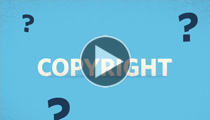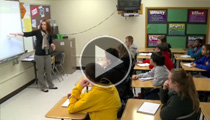
Copyright and Fair Use
-
They are familiar situations—
- There’s a great text we want to use with students, and no funding to purchase a class set.
- We found the perfect graphic or photo pulled from the web to go with a presentation.
- That piece of popular music fits nicely as the theme for a classroom video.
With digital tools now everywhere, it easy to copy and use the materials without a second thought. We are educators, after all, not making any money from the work. Isn’t that fair use?
Copyright Basics
The answer is not that simple. A copyright is the legal protection granted to a creator’s ownership of and control over the work he or she creates. If someone else wants to use that work, they must receive permission from the copyright holder to use, share or perform that work. Written material, including books, magazines, poems, news stories and more; websites, art, graphics, logos, architectural designs, photographs, music and lyrics, audio recordings, movies, TV shows, videos, and video games may be copyrighted.
The easiest way to tell if a work is copyrighted is to look for the © symbol or the word “copyright,” “all rights reserved,” or something to that effect. However, a work has copyright protection even if the © symbol and/or the word “copyright” are not included. If you aren’t sure if something is copyrighted or if the creator allows use by others, it is your responsibility to find out before you use it.
If you want to use something that is copyrighted, there are steps you must follow before you use it.
- Check to see who owns it
- Get permission to use it
- Give credit to the creator
- Buy it (if necessary)
- Use it responsibly
Considering Fair Use
There are times when you can use a small part of another person’s copyrighted material without permission or paying a fee – this is called fair use. Fair use only applies when using content in certain instances including schoolwork and education, news reporting, criticizing or commenting, and comedy or parody. It’s still a good idea to give credit to the creator of the work you use. Specific guidelines must also be followed:
- only use a small amount of the work
- add new meaning to the work to make it original
- rework it and use it in a totally different way
- use it for nonprofit purposes
Additional Definitions
Content that is classified as public domain is not protected by copyright and is free to be used in any way. In general, government works are in the public domain as well as works where copyright has expired. The internet is not the same as the public domain. Creative Commons is a type of license that allows work to be used for free as long as the creator is given credit for it. A work that says it may be used for commercial purpose that means the work may be used for a fee if the work will be used directly or indirectly for profit.
Examples of Practice
- There’s a great text we want to use with students, and no funding to purchase a class set. If that text is published online, you can give the students the direct link to read it digitally instead of making multiple paper copies. You could also use a short selection from the text, or ask the author for permission to use the whole piece.
- We found the perfect graphic or photo pulled from the web to go with a presentation. Check the copyright to see if it has a Creative Commons license for reuse, then cite the source in the final presentation.
- That piece of popular music fits nicely as the theme for a classroom video. If it is not copyrighted for reuse, find a different piece with permission, or use just a few bars as an intro instead of the whole piece.
Basic Recommendations
-
- Use material in the public domain.
- Ask creators for permission to use their work (it’s easier than it sounds!).
- Purchase copies or licenses for all intended users as required by the publisher.
- Give students a link to resources or work instead of making copies.
- Use the option to filter for licensing permissions in Internet website searches.
- Use Creative Commons licensed resources.
- Cite sources.
- Design assignments that are personal and don’t invite plagiarizing.






